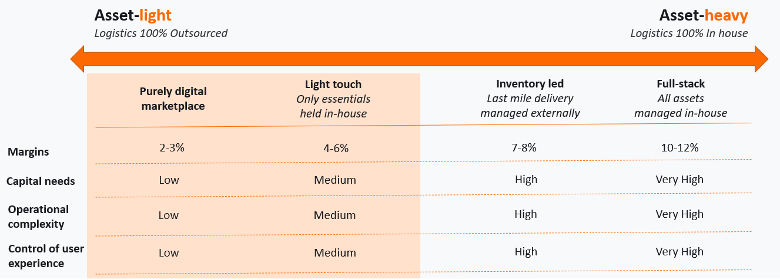
Community pharmacists across Africa do more than just fill prescriptions for patients. They’re also the first point of care for many people, providing basic medical services and consultations for those with limited options for healthcare. However, the logistics of ordering and receiving medicines from suppliers is hindered by poor road networks and significant logistic expenses that reduce margins for these pharmacies. These operational challenges can prevent these pharmacies from keeping their shelves stocked with the medications and healthcare products that their communities need. That’s where Field Intelligence, an Accion Venture Lab portfolio company, comes in. Their platform allows pharmacists in Nigeria and Kenya to order medications from their phones, aggregates demand for direct delivery to their pharmacies, and collects payment via cash or by providing access to inventory financing, alleviating both the financial burden of sourcing for drugs to stock their selves and the logistical complexities of getting medications to their stores.
Marketplaces have evolved into “one-stop shops” for consumers and MSMEs, offering products, financing, and delivery within the same platform. Logistics challenges, including order fulfillment, warehousing and sorting, shipping, and returns, require unique capabilities and account for a significant portion of direct costs. As marketplaces continue to gain traction in emerging markets, they need to manage their logistics expenses effectively, increase margins, and drive down costs while improving customer satisfaction and retention and providing insights for improved product recommendations.
In this article, we will explore some of the best practices for marketplaces to optimize logistics based on Accion Venture Lab’s experience investing in 65 inclusive fintech companies in emerging markets.
Challenges along the logistics value chain for marketplaces
To establish best practices for building capital-efficient logistics businesses, we must first identify the key challenges along the logistics value chain. From our experience, we can bucket the logistics value chain for marketplaces into three main categories, each with specific challenges:
- Forecasting and managing inventory: Sales can be inconsistent for small businesses, making it difficult to predict their inventory needs. Keeping small businesses’ shelves stocked properly can be challenging due to:
- Inability to forecast demand, including managing inventory turnover of small businesses.
- Availability and cost of inventory.
- Cost of storage at scale.
- Handling pilferage.
- Disposal of unsold inventory.
- Handling physical movement of goods: In both urban and rural communities, transporting goods from manufacturers to their customers is a challenge due to:
- Poor middle-to-last mile infrastructure (e.g., roads in need of repair in urban areas and lack of feeder roads in rural areas).
- Tech-enabled effective load utilization and route planning.
- Increase in fuel and transportation costs (e.g., checkpoints across different states in Nigeria).
- Determining mode of last-mile delivery: When companies decide how to fulfill deliveries, they must consider:
- Risks when selecting third-party partners.
- Varying levels of insight into end-user data, depending on partnership type.
- Potential increased costs at scale as they grow the business and take on additional customers in a wider geographic area
Different approaches to logistics management
In the search for solutions to these logistical challenges, marketplaces have evolved across a spectrum from asset-heavy models that keep 100 percent of logistics in-house to asset-light models where 100 percent of logistics is outsourced.
Asset-heavy models require companies to invest and build multiple capabilities, such as warehouse management and last-mile logistics, which can be challenging and delay companies in achieving break-even. On the other hand, asset-light models outsource all logistics, allowing companies to focus on their core business. However, focusing solely on asset-light models comes with its own distinct challenges.

Inventory-led marketplaces may be more appropriate in markets with logistical challenges or with customer demand for low turnaround time (TAT). Our portfolio company, Semaai is an excellent example of an inventory-led marketplace. On the other hand, in markets where marketplaces’ customers are purchasing commodity goods with predictable and longer turnaround times, we think light touch or purely digital models work better because:
- Companies can significantly improve their control over the user experience by implementing technology for inventory tracking in collaboration with suppliers, streamlining end-to-end order flow management, and effectively managing Third-party Logistics (3PL) partners.
- These models require comparatively low working capital and can scale sooner in markets where access to debt is a challenge, achieving positive contribution margin sooner.
- Asset-heavy models require that companies invest in and develop various in-house capabilities, like warehouse management and last-mile logistics. This can be challenging and lead to a longer time before reaching break-even.
5 metrics to track for building efficient logistics in a marketplace
Regardless of a company’s approach to logistics management, building capital-efficient logistics businesses requires following best practices such as investing in back-end technology, establishing strong vetting and selection criteria for 3PL partners, and focusing on customer experience through regular feedback.
It is also important to monitor metrics to track the efficiency of marketplaces’ logistics capabilities. These metrics include:
1. Cash conversion cycle (CCC): Measures the time it takes for a company to convert its investments in inventory and other resources into cash flow from sales. Understanding the CCC is especially important in a marketplace where businesses rely on a complex network of suppliers, manufacturers, and distributors to move products from one place to another. By tracking the CCC, businesses can identify the areas of their supply chain that are slowing down the conversion of inventory into cash and take steps to speed up the process. Each component of calculating CCC will provide important intel on the business model.
- Inventory days: The average time a marketplace takes to turn its inventory into sales. The average number of days a company holds its inventory before selling helps assess the efficiency of inventory management and can reveal potential issues in the supply chain, such as carrying excess stock or inadequate stock levels.
- Receivable days: The average duration a marketplace takes to collect payment from its customers after a sale is made. Given that marketplaces often act as intermediaries between buyers and sellers, tracking receivable days is critical to build an efficient business.
- Payable days: The average time a marketplace takes to pay its suppliers and other vendors for goods or services.
CCC can be calculated from the above parts as: CCC = Inventory days + Receivable days – Payable days
2. Average order value (AOV): Measures the value of an order and thus is a good proxy to estimate the size of an order. Tracking AOVs is important because they indicate the customer’s wallet share within the marketplace. They also show optimized utilization of logistics as lower AOVs can lead to inefficient shipping and, consequently, higher logistics costs as a percentage of revenue.
3. 3PL partner performance: It is vital to track 3PL delivery success rates and load utilization to maintain customer satisfaction and avoid cost increases.
4. Logistics cost as percentage of revenue: Marketplaces must manage a healthy contribution margin 1 (CM1) to stay sustainable. CM1 is calculated after subtracting direct costs from gross margin. While there are various components of direct costs, which are costs incurred during fulfilment of services, logistics is the largest direct cost component that a marketplace incurs, making this an important metric to track and use to develop guardrails for efficient marketplace operations.
5. Customer experience: Encompasses various aspects of the delivery process, such as the speed, accuracy, and reliability of shipments, as well as the quality of customer service and communication throughout the order fulfillment process.
- TAT vs customer expectations: Depending on the product, customers have different expectations on turnaround time (TAT), and aligning TAT with those expectations is vital for success.
- Order fill rate: Measures the effectiveness of a company’s ability to fulfill customer orders, resulting in greater customer satisfaction and potentially increased sales.
By monitoring these metrics, companies can identify areas for improvement and make data-driven decisions to optimize their logistics operations.
Case studies from inclusive fintechs in our portfolio
Field Intelligence: A B2B platform revolutionizing health supply chains for community pharmacies

Field Intelligence is a full-stack embedded finance company that aims to improve health supply chains in Nigeria and Kenya. They offer a comprehensive suite of solutions, including software for pharmacies to digitize their processes end-to-end, intelligence insights for workflow automation, access to an extensive catalog of medications and healthcare products for purchasing, and embedded supply chain financing to expand pharmacies’ access to necessary drugs.
Notable achievements since our investment in Field Intelligence
Since our investment, Field Intelligence has made significant strides in supporting healthcare providers and expanding its business. They have supported 40,000 private and public points of care, enabling 500 million health interventions. Additionally, they have successfully onboarded over 1,300 pharmacies and achieved impressive financial growth, with a 6x increase in revenue and a 4x increase in gross margin.
Key learnings from logistics management
- Improving order fill rates in Tier 2 and 3 cities: Field Intelligence’s order fill rates are ~90 percent vs. ~40 percent with incumbents due to its centralized sorting facility in Nairobi and Lagos.
- Managing customer demand: Offering stock counts and expiry tracking gives real-time inventory view and enables better recommendations.
- Leveraging logistics and warehousing partners: Field Intelligence offers aggregated delivery days twice a week to reach Tier 2 and 3 cities which streamlines operations, reduces costs from partially filled delivery logistics, and helps pharmacies plan ahead.
Agrim: A B2B platform revolutionizing agri-input retail procurement

Agrim is a B2B platform that assists agri-input retailers in India to discover products and procurethem directly from manufacturers. The platform leverages data to provide inventory financing to the retailers on its platform. Operating as a marketplace, Agrim holds minimal inventory in-house and manages last-mile logistics through third-party logistics providers.
Impressive accomplishments since our investment in Agrim
Since our investment, Agrim has achieved remarkable success in the agri-input retail space. The platform has onboarded over 12,000 agri-input retailers and more than 50 manufacturers. In addition, it has sold over 1,000 product SKUs, generating $27 million in Gross Merchandise Volume (GMV) for agri-input retailers on its platform. Agrim has also experienced a significant 4.5x GMV growth and has become contribution margin positive.
Key learnings from logistics management
- Leveraging technology: Tech can help track inventory available with suppliers and reduce pre-dispatch order cancellations.
- Minimizing returns: Need to perform pre-dispatch quality checks and order reconciliation in order to reduce order returns (which significantly impacts margins).
- Improving customer experience: Meeting TAT consistently is required to build trust with customers; need for order management tech to manage 3PL providers, especially for part-truck load orders.
Managing logistics effectively is critical for fintech marketplaces to increase customer satisfaction and retention, drive down costs, and gain insights for improved product recommendations. By adopting best practices and tracking key metrics, fintech companies can build capital-efficient logistics businesses and succeed in offering embedded financial services on marketplace platforms. As the company scales, the appropriate logistics management model will continue to iterate while a focus on cash conversion cycle ensures the business remains scalable without the need to lock massive amounts of capital. By tracking these metrics, companies can build capital-efficient logistics businesses and succeed in offering embedded financial services on marketplace platforms.
For more insights, follow us on LinkedIn. Reach out to the author, Africa Investment Officer Jasiel Martin-Odoom on Twitter if you’re building embedded fintech in marketplaces or want to learn more about Accion Venture Lab’s investing in Africa.









